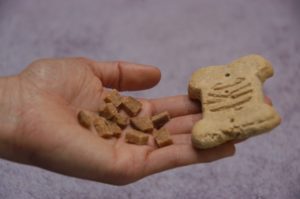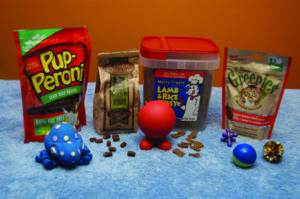Question:
I love watching your videos. What treats do you use in your veterinary practice? They seem pretty irresistible. They also look like they are something that allows them to nibble off small pieces at a time. We have trouble finding something the fearful or anxious dogs will eat.
Thanks!
Lily from Grand Rapids, Michigan
Answer:
I use a variety of semi-moist treats such as Pup-Peroni and Natural Balance Food Roll which can be cut into variable-sized pieces and nibbled off in little bits at a time. The ability for dogs to nibble small pieces comes in handy for keeping dogs focused on the food during potentially scary procedures and, thus, helping to control their head. I also keep treats such as canned spray cheese and baby food in my food arsenal, just in case.
You’re right in that using really tasty treats in the hospital setting is important. I often have people tell me dogs won’t take treats in their hospital and then I find that their giving treats that are about as enticing to dogs as celery is to kids. If you use boring dry dog biscuits, only the happy-go-lucky chow hounds, who don’t really need treats to have a good hospital experience, will eat them. But if you start with something most dogs love, it makes a big difference.
That said, the environmental set-up, as well as how the treats are delivered, will make a huge difference too. For instance, even though I see a huge number of fearful and anxious dogs in behavior consults, most of these dogs readily take treats during the course of the consult. I ask the owners to withhold food that day since the dog may get its meals-worth of food in treats during the consult. Then there’s the hospital set-up. The waiting room of our hospital is comfortable and calm and my behavior room has throw rugs or fleece beds, chairs that look like couches, dog toys, and other homey things. You’d be surprised the difference that a little washable bathroom rug makes in improving the dog’s comfort level quickly.
Next, when I first greet the ambivalent dog, if he does not immediately look relaxed or approach me, I just ignore him and talk to the owner. I let him see that I have food, which I may discreetly toss to him. Once these dogs have had a few treats from a safe distance in the absence of people staring at them, they quickly warm up. Pretty soon they’re walking right up and offering a sit to earn treats. Even the dogs who won’t initially take treats tend to eat the treats after they habituate to the room for several minutes, especially when it’s clear I’m not going to put any pressure or demands on them. For a regular veterinary health exam, the perfect time to inconspicuously toss treats to a dog who won’t yet take them by hand is when the technician is doing the pre-examination history.
Once you put all of these things together-starting with a hungry dog in a dog-friendly room and a ho-hum low key greeting you’ll find that most dogs will eat almost any semi-moist, tasty treat you offer them.
For more information on these techniques refer to Low Stress Handling, Restraint and Behavior Modification of Dogs and Cats book.




